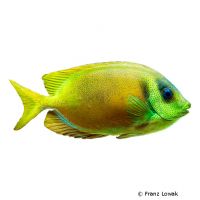Blue Spotted Rabbitfish (Siganus corallinus)
| Blue Spotted Rabbitfish Siganus corallinus | |
|---|---|
| Name | Blue Spotted Rabbitfish |
| Name Lat. | Siganus corallinus |
| Family | Rabbitfishes |
| Family lat. | Siganidae |
| Order | Surgeonfishes |
| Order lat. | Acanthuriformes |
| Origin | Indo-Pacific |
| Habitat | Lagoons, seagrass beds |
| Diet | Herbivore |
| pH | 8.1-8.4 |
| Hardness | 8-10 °KH |
| Behavior | Peaceful |
| Keeping | Individual, pair |
| Reef Compatible | Yes |
| Care Level | Moderate |
| Life Span | 8-12 years |
| Protection | No |
| Metric Units | |
| Size | 20 cm |
| Temperature | 24-28 °C |
| Salinity | 33-36 ‰ |
| Aquarium | ~ 750 l |
| US Units | |
| Size | 8" |
| Temperature | 75-82 °F |
| Salinity | 1.020-1.025 sg |
| Aquarium | ~ 200 gal |
Distribution and habitat
The range of Siganus corallinus is the Indian and Pacific Oceans, from the east coast of Africa, the Andaman Sea, Indonesia and Australia to Vanuatu, where they mostly live in lagoons with dense coral growth and over seagrass and algae beds.
Maintenance
They need a well-structured aquarium with plenty of swimming space and a reef structure (hiding and retreat possibility) with living stones, which they can graze on (algae) and which act like a biological filter as well as fine-grained sand surfaces. Only lime-rich, heavy metal-free sands, gravels, stones or sea sand of various grain sizes may be used as substrate
Filters, skimmers and heaters are necessary to ensure water quality, as well as pumps to simulate tides, swells and bottom currents. Lighting must correspond to the species-appropriate day-night rhythm of the animals
| Salinity: 33-36 ‰ | pH value: 8.1-8.4 |
| Carbonate hardness: 8-10 °KH | Nitrate content: 2-8 mg/l |
| phosphate content: 0.01-0.1 mg/l | nitrite content: 0.0-0.05 mg/l |
For salinity, an average value should be aimed for, which may only vary slightly by +/- 0.5 ‰. Ammonia and ammonium must not be measurable. Special attention must be paid to constantly good water quality.
Diet
They feed mainly on algae. The change of diet does not always succeed without problems. The food supply should consist of a combination of commercially available algae and seaweed (e.g. nori, caulerpa) with scalded lettuce or spinach or a commercially available, vitamin-enriched frozen special food mixture for herbivores. Dry food (granules, tablets) with a high vegetable content is also well accepted. Live or frozen food such as Artemia, Krill or Mysis should only be offered in small quantities. Fine coral sand serves as a digestive aid for them
It is recommended to feed small portions several times a day. Regular and varied feeding promotes health and increases resistance.
Behaviour and compatibility
It is recommended to keep them in pairs. To avoid territorial fights, they should be placed in the aquarium at the same time. They are incompatible with other Siganus species, but can be socialized well with other, not too small fish.
Sex dimorphism
There are no known external distinguishing characteristics.
Reproduction and breeding
There are no known reports of successful breeding in the aquarium.
Important
All hard rays of the fins are connected at the base with a poison gland. Accordingly, special care is required when working in the aquarium. Wearing gloves is recommended in case of direct contact.
As coral reef dwellers, they should not be maintained in a fish-only aquarium. If kept in pairs, with sufficient activity (live stones, large reef surface) and frequent as well as varied feeding, they can be maintained even in demanding coral tanks without attacking the corals
If different species are kept together, care should be taken to ensure that the fish match each other in terms of water quality and temperature requirements, as well as their social behavior, and that the setup meets the needs of all species kept together. New fish to be introduced must be acclimated slowly to the water in the aquarium
Further literature can be found in your pet store.
References
Text: petdata; Image: Franz Lowak
Source: BAENSCH & DEBELIUS (2006): Meerwasser Atlas Bd. 1, Mergus Verlag; ENGELMANN (2005): Zootierhaltung - Tiere in menschlicher Obhut: Fische, Verlag Harri Deutsch
- Gemäß § 21 Abs. 5 Tierschutzgesetz idgF
